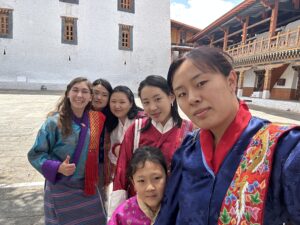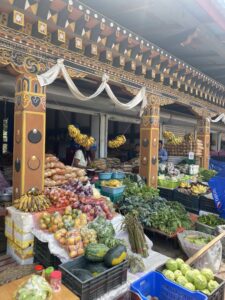Adapting to a foreign culture while abroad is never an easy or straightforward process. However, with time, patience, and some amazing friends, I was able to connect with Bhutanese people and genuinely live the culture in a way I had never thought possible. I can honestly say that it's one of the hardest things I've ever loved doing.
In Bhutan, the formal clothing for women is a long skirt called a kira, which is paired with an inner blouse and an outer jacket known as a wonju and a tego. It's the traditional attire that has been worn for hundreds of years, and it is how people dress in Bhutan to go to school, the office, or the monasteries. I wore the Kira, Wonju, and Tego to class nearly every day. At first, it was a massive struggle and frustration to get dressed every morning-- the first time I tried to get dressed by myself it took nearly an hour to wrap, pin, and fold the layers, sleeves, and collar correctly. Luckily, my roommate was an incredibly patient and kind teacher. We got ready together every morning and after a few weeks, I could get ready in only ten minutes and stopped tripping over the floor-length skirt! After that, older people would stop me on the street and compliment me for how I wore their national dress, and I felt a huge sense of pride in being able to fit in.
I knew I was in trouble when my Bhutanese roommates were confused when I said I thought Indian food was spicy. Chilis are central to Bhutanese cuisine and meals are not considered complete without local chilis cooked into the dish or present on the plate. At first, I turned bright red and cried at every meal, even when my friends would steer me towards dishes they considered mild. However, over time I grew to appreciate Bhutanese cuisine (and found some tricks to tone down the heat!). Now my new problem will be finding a way to recreate my favorite dishes at home!
It's also been a lot of fun to introduce my Bhutanese friends to snacks that I've brought from home. Being from Michigan, I decided to bring cherry candies and jam to share abroad. None of my hallmates had ever had cherries before, and sour candies and jams were pretty foreign to them. Luckily, the treats were a big hit! If you're studying abroad soon, I would highly suggest that you bring snacks to share. Food is a great way to break the ice with new friends, and an opportunity to ask questions and swap stories about each others' cultures.
The Bhutanese way of eating is also very different from what I was used to back home. Traditionally, Bhutanese meals are taken family style with everyone sitting on the ground around bowls of food, as opposed to the Western style of eating at a table with chairs. Unfortunately, I haven't quite mastered the technique of using rice to pick up food while keeping my hands clean yet. But, while it's certainly a little embarrassing to watch a toddler eat with better table manners than me, I've always felt welcome in the households and monasteries that have invited me in to eat with them. In my experience, Bhutanese people are incredibly hospitable. As I've traveled to various small towns and temples across the country, I've found so many people excited to share their food and company with a foreign stranger, dirty hands and all.



